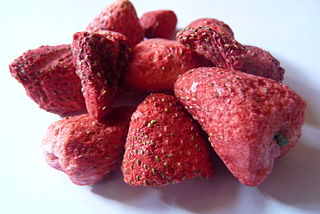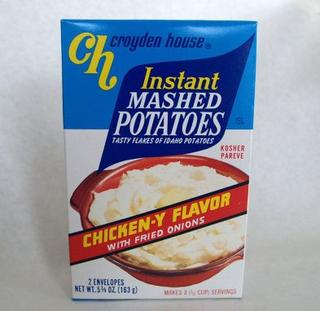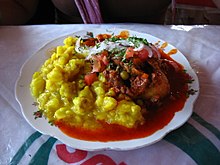
Jerky is lean trimmed meat cut into strips and dehydrated to prevent spoilage. Normally, this drying includes the addition of salt to prevent bacteria growth. The word "jerky" derives from the Quechua word ch'arki which means "dried, salted meat".

The Aymara or Aimara, people are an indigenous people in the Andes and Altiplano regions of South America. Approximately 2.3 million Aymara live in northwest Argentina, Bolivia, Chile, and Peru. The ancestors of the Aymara lived in the region for many centuries before becoming a subject people of the Inca Empire in the late 15th or early 16th century, and later of the Spanish in the 16th century. With the Spanish American wars of independence (1810–1825), the Aymaras became subjects of the new nations of Bolivia and Peru. After the War of the Pacific (1879–1883), Chile annexed territory with the Aymara population.

Andean music is a group of styles of music from the Andes region in South America.

Oxalis tuberosa is a perennial herbaceous plant that overwinters as underground stem tubers. These tubers are known as uqa in Quechua, oca in Spanish, yams in New Zealand and several other alternative names. The plant was brought into cultivation in the central and southern Andes for its tubers, which are used as a root vegetable. The plant is not known in the wild, but populations of wild Oxalis species that bear smaller tubers are known from four areas of the central Andean region. Oca was introduced to Europe in 1830 as a competitor to the potato, and to New Zealand as early as 1860.

Ullucus is a genus of flowering plants in the family Basellaceae, with one species, Ullucus tuberosus, a plant grown primarily as a root vegetable, secondarily as a leaf vegetable. The name ulluco is derived from the Quechua word ulluku, but depending on the region, it has many different names. These include illaco, melloco, chungua or ruba, olluco or papalisa, or ulluma.

Freeze drying, also known as lyophilization or cryodesiccation, is a low temperature dehydration process that involves freezing the product and lowering pressure, thereby removing the ice by sublimation. This is in contrast to dehydration by most conventional methods that evaporate water using heat.

Pachamanca is a traditional Peruvian dish baked with the aid of hot stones. The earthen oven is known as a huatia. It is generally made of lamb, mutton, alpaca, llama, guanaco, vicuna, pork, beef, chicken, or guinea pig, marinated in herbs and spices. Other Andean produce, such as potato or chuño, habas, sweet potato, mashua, oca, ulluco, cassava, yacon, plantain, humitas, ears of corn, and chilli, are often included in the baking.

Carl Troll, was a German geographer, brother of botanist Wilhelm Troll. From 1919 until 1922 Troll studied biology, chemistry, geology, geography and physics at the Universität in München. In 1921 he obtained his doctorate in botany and in 1925 his habilitation in geography. Between 1922 and 1927 he worked as an assistant at the Geography Institute in Munich. Troll was engaged in research in the ecology and geography of mountainous lands: between 1926 and 1929 went on a research journey throughout South American Andean countries where he visited northern Chile, Bolivia, Peru, Ecuador, Colombia, and Panama. In 1933 and 1934 his research interests took him to East and South Africa; in 1937 Troll was in Ethiopia; and in 1954 he visited Mexico.

Quechua people, Quichua people or kichwa people may refer to any of the indigenous peoples of South America who speak the Quechua languages, which originated among the Indigenous people of Peru. Although most Quechua speakers are native to Peru, there are some significant populations in Ecuador, Bolivia, Chile, Colombia, and Argentina.
Peruvian cuisine reflects local practices and ingredients including influences mainly from the indigenous population, including the Inca, and cuisines brought by immigrants from Europe, Asia, and Africa. Without the familiar ingredients from their home countries, immigrants modified their traditional cuisines by using ingredients available in Peru.

Instant mashed potatoes are potatoes that have been through an industrial process of cooking, mashing and dehydrating to yield a packaged convenience food that can be reconstituted by adding hot water and/or milk, producing an approximation of mashed potatoes. They are available in many different flavors.
Chuno may refer to the following:

Chairo is a traditional dish of the Aymara people, consumed mainly in Bolivia and other countries in the Andes.

Inca cuisine originated in pre-Columbian times within the Inca civilization from the 13th to the 16th century. The Inca civilization stretched across many regions on the western coast of South America, and so there was a great diversity of unique plants and animals used for food. The most important plant staples involved various tubers, roots, and grains; and the most common sources of meat were guinea pigs, llamas, fish, and other aquatic and terrestrial organisms (305-307). Cuisine was heavily influenced by the Inca's food storage system, social gatherings and celebrations, and social status (308-315).

Inca agriculture was the culmination of thousands of years of farming and herding in the high-elevation Andes mountains of South America, the coastal deserts, and the rainforests of the Amazon basin. These three radically different environments were all part of the Inca Empire and required different technologies for agriculture. Inca agriculture was also characterized by the variety of crops grown, the lack of a market system and money, and the unique mechanisms by which the Incas organized their society. Andean civilization was "pristine"—one of six civilizations worldwide which were indigenous and not derivative from other civilizations. Most Andean crops and domestic animals were likewise pristine—not known to other civilizations. Potatoes and quinoa were among the many unique crops; Camelids and guinea pigs were the unique domesticated animals.

A qullqa (Quechua pronunciation:[ˈqʊʎˌqa] "deposit, storehouse"; was a storage building found along roads and near the cities and political centers of the Inca Empire. These were large stone buildings with roofs thatched with "ichu" grass, or what is known as Peruvian feathergrass. To a "prodigious [extent] unprecedented in the annals of world prehistory" the Incas stored food and other commodities which could be distributed to their armies, officials, conscripted laborers, and, in times of need, to the populace. The uncertainty of agriculture at the high altitudes which comprised most of the Inca Empire was among the factors which probably stimulated the construction of large numbers of qullqas.
Arequipan cuisine is the cuisine of Arequipa, a regional Peruvian cuisine. Arequipan cuisine is known for its picanterías, traditional local restaurants offering chicha de jora accompanied by four small plates of spicy rocoto seasoned regional delicacies along with singing or music.

Fricasé is a traditional soup in Bolivian cuisine prepared with pork, pork ribs or chicken, hominy, chuño or potatoes, onion, garlic, salt, pepper and spices. It is sometimes consumed as a hangover food, as having a theoretical potential for easing or alleviating symptoms associated with the hangover.

Ocra is a Quechuan Campesino community within the Chinchaypujio District in Peru and about 1.5 hours outside of Cusco; its central village is located at 3,670 m (12,040 ft) altitude.

















